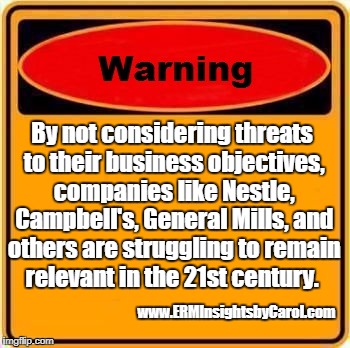One of my recent articles, 8 Possible Consequences of Not Being Proactive in Risk Management, discussed possible ramifications for companies who do not factor risks into decision making. Two of those consequences, product failure and profit/financial loss, came to the forefront of my mind when reading an article from the Wall Street Journal about how staple food brands like Hamburger Helper and Kraft Macaroni and Cheese are struggling.

Once upon a time, products like Kellogg’s cereal, Campbell soup, and others were commonplace in millions of pantries across the U.S. These brands and others like them provided families with safe and affordable food options that were easy to prepare. For companies like General Mills, Conagra, and others, these staples provided a reliable revenue stream over the bulk of the 20th century.
Starting in the 1990s and accelerating in the years following the 08/09 financial crisis, these brands are struggling and now scrambling to reinvent themselves.
And these threats can impact any organization. Let’s take a closer look at each of the threats.
Threat #1: Consumer Expectations for Products and Ingredients
Many consumers are opting for fresher, all-natural food options over the highly processed, artificial dye, and preservative-laden products offered by these big brands.
Many health-conscious consumers, including myself, fit into this category. If you were to take a look at our pantry and refrigerator, you will find little to no pre-packaged, highly processed foods. Megan Dart, a mother of four in Houston, is another example. “We don’t do pre-made meals, no microwave meals,” she explains. “Velveeta. I don’t even know what that is!!”
Although companies like Kraft-Heinz are removing artificial food dyes, nitrates and other additives from many of their products, and their sales and market share have improved somewhat, it’s too late for people like me and Megan. Fresher options and all-natural brands like Annie’s Homegrown, Chobani, and others continue gaining market share.
Regardless of the business they’re in, companies who do not understand changing customers preferences and adjust accordingly will eventually see those customers move to products and services that satisfy this demand.
Threat #2: Consumer Buying Habits and Pricing
The second primary reason for these brands’ decline is that many consumers are opting for lower-price store brands, especially following the crash in 2008. According to a recent report from Credit Suisse, shelf space for private-label products has increased 3.5% annually since 2012. Industry analysts expect these store brands to continue gaining market share, especially as they add all-natural products of their own.
Understanding competitors and adapting strategy to meet the challenge is a key part of maintaining or growing market share. Many organizations get complacent when things are going well and wait until something serious happens before responding.
Threat #3: Technology and Online Availability of Food
Another reason for the decline comes from online sales through sites like Amazon.com and social media. In the pre-Internet age, big food brands could count on prominent shelf placement and TV advertising to control perceptions. Today’s “endless shelf,” as it’s called by Nestle CEO Mark Schneider, referring to the internet, dramatically lowers the barrier of entry, giving smaller companies the opportunities they could only dream of in past decades.
Social media poses a dual-threat (…and opportunity) to established brands like General Mills. Not only is it easier for consumers to share frustrations, preferences, etc., it’s much easier for small start-up brands to market their products.
On the other hand, marketing costs on social media vs. TV are much lower, which helps big brands too. E-commerce through sites like Amazon.com and others makes getting new products into the hands of individual consumers much easier.
When the movement toward fewer artificial ingredients and additives began in mid-1990s, these large food companies generally took a wait and see approach. As explained by food historian Andrew Smith, they “…ignored the concerns, and they stopped experimenting because they could buy aisles in the grocery store.”
However, ignoring the threats posed by changing consumer preferences, lower-priced store brands, and the growth of social media has cost these companies dearly. They can no longer count on prominent shelf space and TV advertising spots to deliver the results they once enjoyed.
By not proactively identifying, assessing, and managing threats AND opportunities to achieving their business objectives, companies like General Mills, Conagra Foods, and other brands that once seemed “too big to fail” are now being challenged.
Now that they are noticing an impact to their bottom-line, they are taking steps to turn things around, with one example being Campbell’s purchase of organic soup and healthy-meal company Pacific Foods for $700 million.
But is it too little, too late? Only time will tell…
How do you think the trend toward fresher, organic, minimally processed food will impact the food industry in the decades ahead?
Please don’t hesitate to share your thoughts below, or join the conversation on LinkedIn.
If you are need some guidance on ways you can identify these threats before they become reality, check out my free eBook on 5 Effective Methods of Risk Identification and an earlier post on how General Motors identifies emerging risks. And you can always subscribe to my blog to receive the latest from ERM Insights by Carol directly in your inbox.









